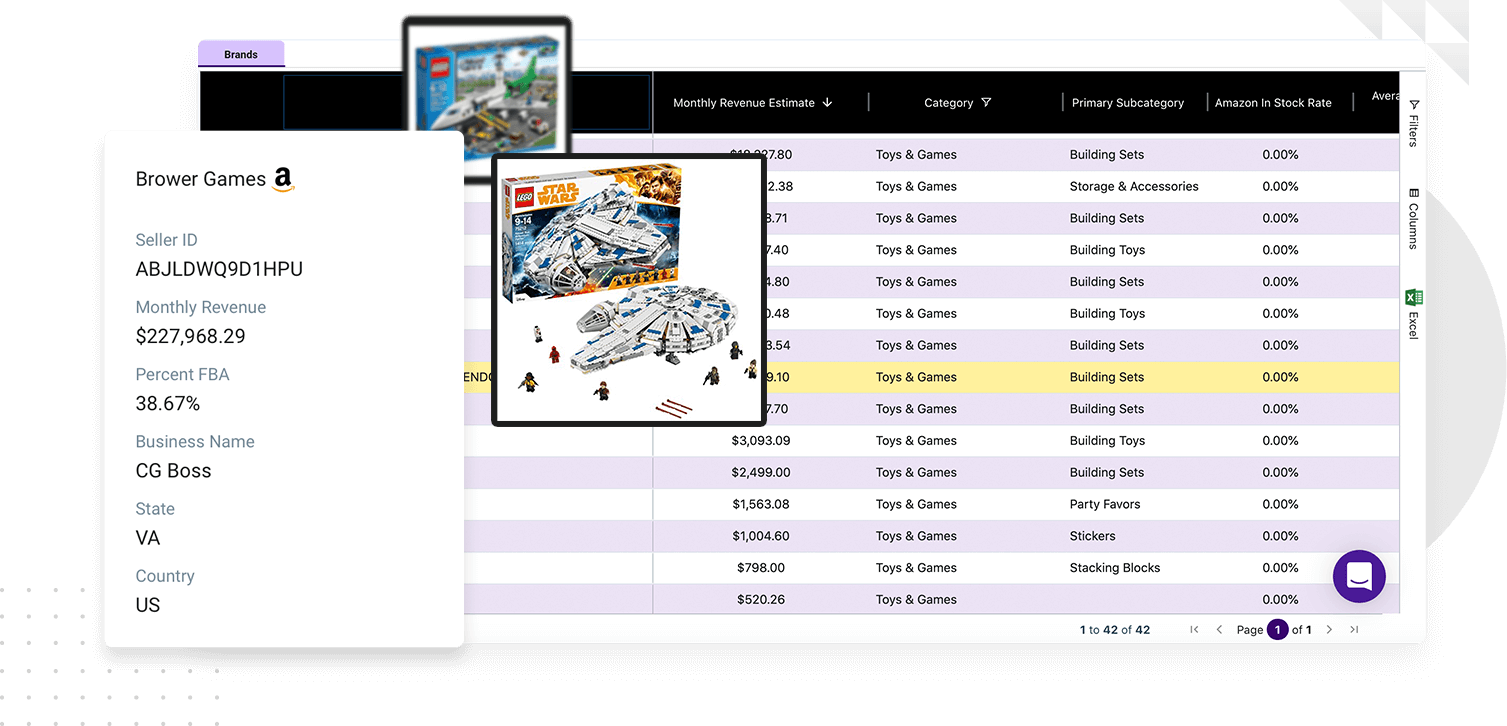Amazon’s marketplace is a beast with endless brands, yet believe it or not, over 240,000 brands on Amazon aren’t reaching their potential. We’re talking about each leaving an eye-popping $20,000–$100,000 per month in revenue on the table.
Inhaltsverzeichnis
For savvy third-party sellers like you, that’s not just a fun fact, it’s a giant neon opportunity sign. The catch? Figuring out which of those brands are worth your time (and which are just one-hit wonders) is tricky. That’s where tools like SmartScout come into play, shaking up how we navigate Amazon’s jungle and turning brand hunting into a slick, data-driven dance.
The evolution of brand hunting on Amazon
Not so long ago, Amazon selling was all about chasing the next hot product. It felt like a frantic treasure hunt for trending items. Fast forward to 2025, and the game has flipped on its head. Brand hunting today isn’t about products, it’s about partnerships. Instead of just finding a product to resell, you’re forming strategic alliances with established brands.
With SmartScout in your toolkit, you can zip through this new process at warp speed
Its brand-hunting wizardry lets you quickly pinpoint legit brands on Amazon that aren’t already snapped up by Amazon Retail or locked down by an exclusive seller. In other words, you’re identifying brands that are up for grabs. This shift in approach is not just refreshing, it’s incredibly exciting for those of us looking to build lasting Amazon businesses.
What is brand hunting?
So, what exactly is “brand hunting”? Think of yourself as Indiana Jones, but instead of golden idols, you’re after under-the-radar brands that could use a helping hand on Amazon. Brand hunting is essentially using data and research to find established yet underperforming brands that are hungry for third-party sellers (like you) to step in and boost their Amazon game. The goal is simple: zero in on brands with steady, consistent demand, and skip the fleeting fads and seasonal crazes. We want brands that sell day in, day out.
This is where SmartScout becomes your treasure map. SmartScout has a massive database of over 240,000 Amazon brands and lets you filter down to the gems. You can target brands doing roughly $20K–$100K in monthly revenue, a sweet spot where they’re successful but still have plenty of room to grow. Importantly, these target brands also have a healthy mix of sellers (meaning they’re not exclusive to one seller or Amazon itself). In plain English: brand hunting is all about finding those solid brands that have good sales and need a partner, you, to help take them to the next level.
SmartScout’s “Brands” feature
Imagine having a gigantic library of Amazon brand data at your fingertips. That’s essentially what SmartScout’s Brands feature gives you. It unlocks a database of 240,000+ brands, each with juicy stats and analytics. You can see critical info like who’s controlling the Buy Box, how many sellers are sharing it, if Amazon itself stocks the brand’s products (and how often), and even where the brand’s listings might be poorly optimized. It’s like x-ray vision for brand scouting.
Using SmartScout, you can either search for specific brand names (if you have some in mind) or apply a bunch of filters to find brands that meet your ideal criteria. Want a brand in a certain category with high sales but low Amazon presence? No problem, set those filters and SmartScout will serve up a list of matching brands in seconds. In short, the Brands tool turns what used to be hours of research into a quick, systematic scan for your next wholesale partnership. It’s Amazon brand scouting on steroids (the legal kind 😜).
What filters should you use for Brand Hunting?
SmartScout’s power comes from its ability to filter down that huge list of brands to the real opportunities. But which filters should you use to find the golden brands? Here are the key filters I recommend tweaking, and why they matter:
Filter | Recommended Setting | Why It Matters |
Amazon In-Stock Rate | Max 50% | Avoids brands where Amazon itself is the seller too often (so you’re not competing with Amazon for the Buy Box). |
Dominant Seller Sales % | Max 50% | Sidesteps brands tied up by one seller (ensures no single seller has more than half the sales). |
Average FBA Sellers | Min 3 | Hints at open distribution – the brand works with multiple third-party sellers, not just one or two. |
Monatliche Einnahmen | $20K–$100K | Targets brands with decent sales but still “accessible” (not so big that they won’t talk to smaller sellers). |
Average Price | Min $25 | Ensures juicy margins (higher-priced products leave more room for your profit after costs). |
With these filters set, you’ll generate a list of brands that meet the perfect criteria for outreach: they aren’t dominated by Amazon or a single seller, they have a few sellers already (so they’re likely open to wholesale relationships), they’re doing a respectable amount of revenue, and their price points suggest you can make money selling their products. That’s the recipe for a promising wholesale lead.
How to contact brands once you've found'em
Alright, now you’ve got a hot list of target brands. Next step: reaching out and striking a deal. Approaching brand owners can be intimidating, but it doesn’t have to be. Here’s how to find the right contact info and make your pitch count:
Finding contact info
- Google is your friend: Do a quick search for the brand name plus terms like “wholesale”, “reseller program”, or “authorized dealer”. Many brands have dedicated pages for wholesale inquiries or reseller applications (sometimes hidden in plain sight on their website).
- Check the brand’s website: Take a peek at the footer, FAQ, or “Contact Us” pages on their official site. Often you’ll find a “Retailers” or “Distributors” section, or at least an email address for sales inquiries.
- Use email-finding tools: If you’re coming up empty, tools like Hunter.io can help sniff out email addresses associated with the brand’s domain. LinkedIn can also be useful to find the right person (e.g., sales manager or partnership manager) to contact.
Outreach strategy
- Be an e-commerce ally, not just another seller: When you reach out, position yourself as a partner who can help the brand grow on Amazon, rather than just someone looking to buy their stuff. Your tone should say, “I’m here to add value to your brand,” not “I’m here to make a quick buck off your products.”
- Showcase what you bring to the table: This is your chance to shine. Do you have experience optimizing Amazon listings for SEO? Great at running PPC campaigns? Maybe you’re awesome at inventory management or have a track record of boosting sales for other brands. Let them know! For example, you might say you excel at enhancing product pages (better images, copy, keywords) or that you’re vigilant about brand safeguarding (keeping an eye out for counterfeiters or MAP violators). Make it clear that you’ll treat their brand like your own.
- Have a Plan B (Distributors): Some brands might reply, “Sorry, we don’t work directly with Amazon sellers.” Don’t give up there. Ask if they have any authorized distributors or wholesalers you could purchase from. Sometimes getting in with a distributor is easier and can lead to selling the brand’s products without a direct account. It never hurts to ask for a referral, it shows you’re serious about selling their brand one way or another.
Approach each brand professionally but with personality. You’d be surprised how far a friendly, knowledgeable email can go. And remember: the goal is to build a relationship. Even if you get a “no” today, a well-handled conversation can turn into a “maybe later”.
Tl; dr
Brand hunting is all about working smarter, not harder. By identifying established brands that need a boost and positioning yourself as the ideal partner, you create a win-win scenario. SmartScout is the sidekick that helps you find those opportunities faster and with laser precision. So, if you’re an Amazon seller looking to level up, give this approach a try.
Dust off that virtual treasure map and start hunting for your next big wholesale partnership. Who knows, your Amazon empire might just be one smart deal away. 😉 Happy hunting!
Weitere Beiträge
Über den Autor
Jordi Ordonez
Ich bin ein unabhängiger E -Commerce- und Amazon -Berater.
Kunden, die
ich mit Marken wie Estrella Damm, Intersport, Bella Aurora, Lladró, Textura-Innenräumen, schönen Dingen Palomas, Castañer, Due-Home und viele andere gearbeitet habe.
Lecturer & Teacher
I've spoken and taught at events such as Meet Magento, PrestaShop Day, SEMrush, Cambra de Comerç Barcelona, ClinicSEO, EcommBeers, EcommBrunch, Ecommercetour.com, EcommFest, EOI, ESIC-ICEMD, Foxize, Generalitat de Catalunya, Inesdi, Quondos, and The Valley. Ich habe auch Trainingseinheiten für wichtige Marken wie Orange und Adidas durchgeführt.
Autor
Ich stufe regelmäßig Artikel zum Helium 10 Blog , Shopify , Semrush , La Vanguardia , E -Commerce News , Marketing4ecommerce und anderen bei.
Partner
Helium 10 , Jungle Scout , Avask , Helium 10 Seller Solutions Hub-Partner , SaaS4Marketing , H10-WP.com , FBAsuite.com und vertrauenswürdiger Partner von Tracefuse .
Social
LinkedIn , Twitter , Wikipedia , YouTube , Quora , ISNI 0000000513224289 , Über Jordi Ordonez





